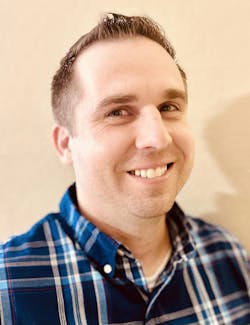SLC 2024 Preview: Finding the Best Safety Candidate for the Best Safety Job
When it comes to the hiring process, there’s a lot of pressure to have the best: the best candidate, the best job, the best compensation package, the best employer with the best culture.
But what if, in our quest for betterment, we’ve actually made things worse?
Evan Kopshy, lead HSE engineer at Honeywell Aerospace, says the hiring process has become confusing, if not downright broken, over the past few years. There are plenty of reasons why that’s happened, and some of those are beyond the scope of EHS professionals.
However, there are plenty of things EHS professionals can do, whether you are hiring or job hunting, to make the process better for everyone. That starts by being honest about what you want and need, both as an employer and as an employee, then taking the appropriate action.
Kopshy will speak about his experiences both as an EHS professional and EHS manager at the 2024 Safety Leadership Conference that’s taking place Aug. 26-28 in the greater Denver area. More information, including registration, can be found here. Below is a preview of what to expect from Kopshy’s presentation.
EHS Today: How did the EHS hiring system get broken? What happened?
Kopshy: In the EHS industry, we love to conduct root cause analyses on things that have gone wrong. If someone gets hurt, we have a permit excursion. If there is a near-miss, we conduct an investigation and find the system or person that failed. But as much fun as it might be to do a failure analysis on the EHS hiring system, there is too much data and too many failure points to narrow down the cause to any specific point.
Obviously, we, as EHS professionals, are partly at fault. However, the failures run the gamut to include organizational structures, the economy, our human resources partners and an ever-changing EHS regulatory landscape. There are more causes out there but, honestly, we cannot focus on all the causes.
This discussion will, instead, focus on EHS leadership and their partnership with our HR team members. We can control our own actions and choices. We, unfortunately, cannot control many of the other potential causes.
What are some of the pain points for employers that are hiring EHS professionals?
When we are looking to hire, we struggle to market to the candidates we want. Across the EHS community, we use titles like manager, coordinator, director, leader and supervisor almost interchangeably.
We also have decided that every EHS professional should be an expert in every EHS discipline. Part of that is our inherent desire to mitigate risk. The mindset is: If I get to hire someone, I want to hire someone who can address my current needs—and any future needs that I haven't yet learned of.
The greatest pain point is that we don't know what we want. Even if we do, we don't do a great job of communicating it.
What are some of the pain points for EHS professionals who want to be hired?
The pain points for prospective employees are the direct result of the pain points that employers face. No one knows what EHS titles mean anymore, and your current title may or may not reflect your actual work or potential. Take me, for example. I started as a leader, moved to an associate engineer, then became a coordinator, went back to an engineer, then to manager and am currently a lead engineer. All were with different organizations, all were—at least in my mind—promotions, and all had different levels of responsibility.
To battle the confusion on what the titles mean and what the role may actually entail, candidates fill their resumes with enough information to make it clear they are an expert in every possible EHS discipline. And even though I think the world of myself, I know that there are very few EHS professionals who are truly experts in everything, especially me.
What can be done to improve the EHS hiring process?
This has to start with employers and EHS leaders. We have to know what we are hiring for and make that clear in the job posting, phone screenings, interviews and anywhere else we might communicate with a candidate. The hardest part is following through on that commitment.
Most EHS professionals who have been in the field for a few years have accepted a new EHS role without a clear understanding of the role they were accepting. As employers, we try not to reveal too much, because we do not want to scare away candidates. And, as candidates, we don't want to ask too many questions because we want to appear willing to do whatever is asked. Also, finding a new job tends to be exhausting.
By the time we fully understand the role we have gotten ourselves into, it is too late to back out. And by the time an employer realizes the capabilities of their new EHS hire, it is too late to try again.
What does it mean to hire for a purpose?
Hiring for a purpose sounds so easy—and it can be easy. The simplest approach is to write a great job posting. Not a rambling posting that no one will read through, but a short and concise one.
The first few bullet points should accurately describe 75% of the work that will be done. What programs will they run? What type of industry will they be working in? What regulations will they have to comply with? This can make it clear whether it is a health role, an environmental role or a safety role.
Even if it is a role that truly requires a generalist, the first few bullet points should make this clear. If we know what we are looking for, then we can find it more easily. Once we know what we want, we can target candidates who are experts (or show potential to be experts) in those disciplines. Simply put, hiring for a purpose is hiring the right candidate—on purpose.
How do hiring woes fit into the bigger picture for the EHS profession?
EHS professionals are tired. We are moving into roles to escape our current roles because the job posting was confusing, misleading, inaccurate or an outright lie. The new positions have the same problems as the previous position. As EHS professionals move over and over again, employers are desperately trying to fill vacancies with whomever they can find.
We focus on filling roles quickly, not correctly, leading to more turnover and frustration for all parties involved. And then we enter that retention death spiral that burns out our team members.
But what really hurts is when you hire a passionate EHS professional into a role where they do not get to follow their passion, and they lose that fire for EHS. I had a construction safety-oriented individual working for me in a non-construction role. He came from construction. He had started out as a tradesman but left construction because he thought that was the path he was supposed to take.
When I became his boss (two months after he started in his role), he already knew he hated the work. He didn't hate safety, but he hated non-construction safety. He was a great employee, but I spent a significant amount of time encouraging him to follow his passion and helping him get back over to construction. For over a year, I have received regular updates from him celebrating his joy at working 12-hour shifts on construction sites with the people he cares about most. Our current hiring practices stifle that passion.
Can you elaborate on the opportunities to, or the benefits of, specialization with the EHS profession?
Oh man! Specializing is what so many other professions do. A technician at an assembly plant makes a single part or product over and over again. But in the EHS world, specializing is tantamount to treason.
We want every EHS hire to be an expert in everything, but we are always quick to hire a consultant who specializes in one thing. But that expert knowledge that companies crave does not come from a generalist; it comes from someone who has been allowed to focus on one discipline.
From an employer’s standpoint, it is easy to find an expert and allow them to thrive, if we know that is what we are looking for. But, as an applicant, professing to be an expert on one thing is a kiss of death. So, we take our resumes and profess to be an expert in all things. But, if everyone is an expert in all things, how can we find the true expert we need?
If a safety professional is applying to jobs, what's something you recommend they do on their resume?
There are so many resume experts out there, but my recommendation is to use broad strokes, be honest and tailor your resume for the job you want to find. I can't promise that will get you the job, but it will keep you from getting the job you don't want.
My resume talks a lot about leadership, people, teaching, auditing and change. That has led me to my current role, the first EHS job I have loved in several years. Previously, my resume was a standard EHS approach. I was familiar with everything from LOTO to wastewater treatment to respirator fit testing to electrical safety. That led to several roles that almost killed my passion for EHS.
What should employers look for in a resume?
Look for what you need as the minimum. Recruiters will send just about anyone through that looks like they have been in an EHS role for the minimum amount of time. But, as EHS professionals, we can look closer to make sure their experience lines up with our needs for the role.
And, if they specialize in what is needed, give them a chance. Allow them the opportunity to demonstrate a capacity to learn more if they already have the needed skill set.
What's one thing you hope attendees take away from your session at the Safety Leadership Conference?
Each one of us, whether we are looking for a candidate or looking for a job, needs to take ownership of the EHS hiring process. We do not need to change the whole industry to change our organizations—or our careers. Take action for yourselves and let it influence the culture across the industry. We have to believe that is possible, or we wouldn't be EHS professionals.
About the Author
Nicole Stempak
Nicole Stempak is managing editor of EHS Today and conference content manager of the Safety Leadership Conference.


